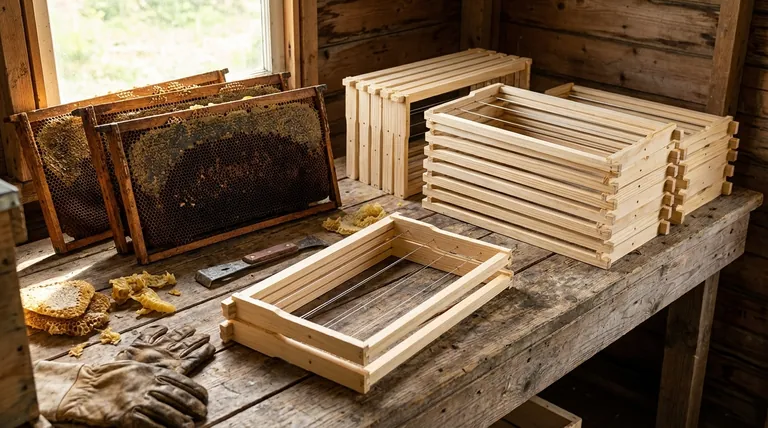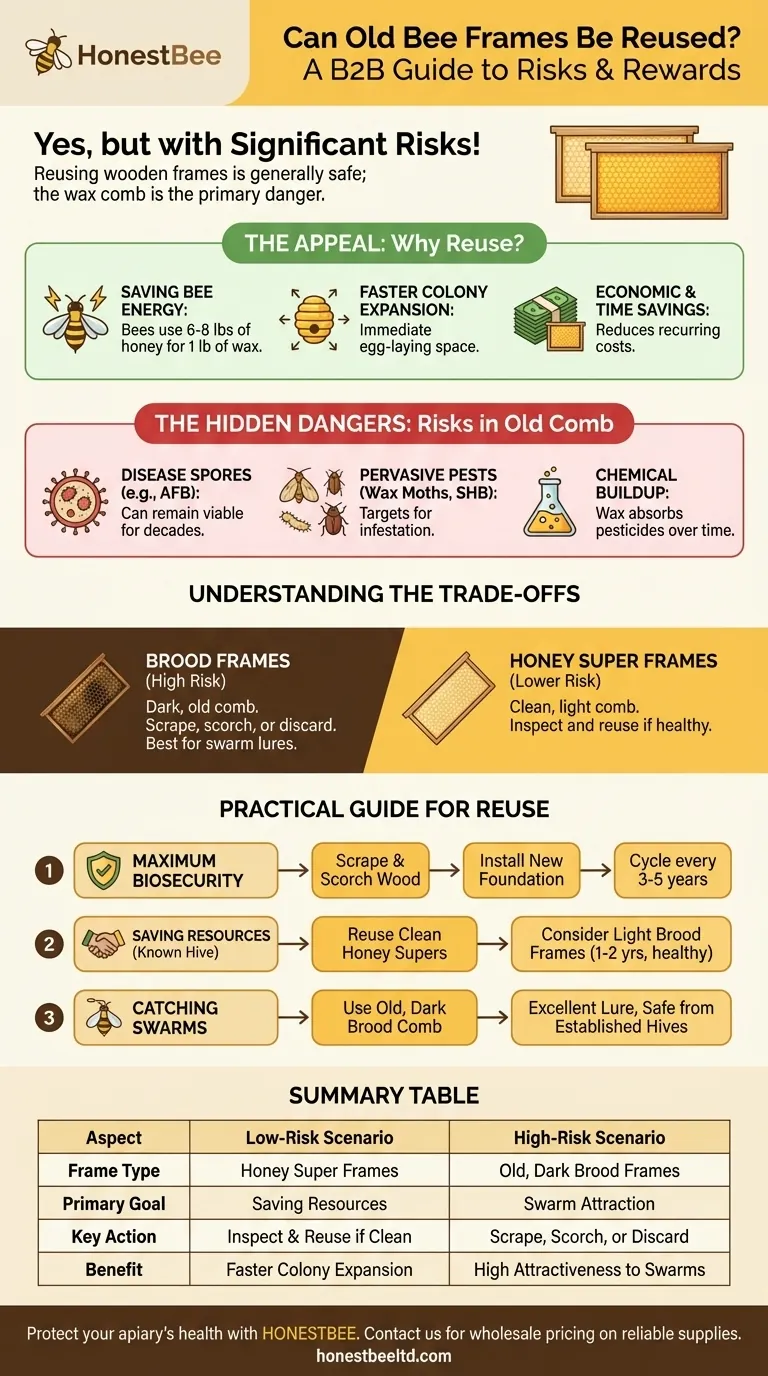Yes, old bee frames can be reused, but this decision carries significant risks that every beekeeper must understand and mitigate. While it can save time and resources, reusing frames—especially the drawn comb—can introduce devastating diseases and pests into a healthy colony if not handled with extreme care.
Reusing the wooden frame itself is generally safe after proper cleaning. The primary danger lies in reusing the old wax comb, which can act as a reservoir for disease spores and chemical contaminants that threaten the long-term health of your hive.

The Appeal of Reusing Old Frames
Beekeepers are drawn to reusing old equipment for several valid reasons. Understanding these motivations is the first step toward making a safe and informed decision.
Saving Bee Energy
Drawing out fresh wax foundation requires a tremendous amount of energy from the colony. It is estimated that bees consume 6-8 pounds of honey to produce just one pound of wax. Providing them with already-drawn comb allows them to immediately focus on raising brood and storing nectar.
Faster Colony Expansion
For a new package, nuc, or a freshly caught swarm, drawn comb provides an immediate advantage. The queen has a place to start laying eggs right away, accelerating the colony's population growth and establishment.
Economic and Time Savings
Foundation and frames represent a recurring cost for beekeepers. Reusing equipment reduces this expense and saves the time associated with assembling new frames and embedding foundation.
The Hidden Dangers in Old Comb
While the benefits are clear, the risks are severe and often invisible. The wax comb, not the wooden frame, is the primary source of danger.
The Primary Threat: Disease Spores
Old comb can harbor microscopic spores from serious honey bee diseases. These spores can remain viable for decades, waiting to infect a new colony.
The most dangerous of these is American Foulbrood (AFB). It is so infectious and persistent that in many regions, the only legal and effective treatment is to burn the entire hive, including bees, frames, and boxes.
Other diseases like European Foulbrood (EFB) and Chalkbrood can also persist in old comb, creating a cycle of infection that weakens and stresses the colony.
Pervasive Pests
Old, stored frames are a primary target for pests. Wax moths can quickly move in and reduce beautiful drawn comb to a mess of webbing and debris. The Small Hive Beetle (SHB) can also lay eggs in stored comb, leading to a fermented, slimy infestation.
Chemical and Pesticide Buildup
Beeswax acts like a sponge, absorbing chemicals from the environment and any treatments used within the hive. Over several years, pesticides, herbicides, and miticides can build up to toxic levels in the wax, potentially harming brood development and overall colony health.
Understanding the Trade-offs: Risk vs. Reward
The decision to reuse frames is a calculated risk. You are weighing the immediate benefits of saved resources against the potential for catastrophic colony loss.
Brood Frames vs. Honey Super Frames
There is a critical distinction between frames used for brood (where the queen lays eggs) and those used for honey storage.
Brood comb, especially comb that is dark brown or black with age, is the highest risk. It has been exposed to generations of brood, waste, and potential pathogens. Most experts recommend against reusing old, dark brood comb from an unknown source.
Honey super comb is generally safer. Because it is used only for storing clean nectar and has not housed brood, the risk of disease transmission is significantly lower.
The Problem of Unknown History
If you acquire used equipment or are unsure of a hive's history, you cannot know if it died from disease. Reusing frames from a colony that collapsed for an unknown reason is gambling with the health of your other hives.
A Practical Guide to Reusing Frames Safely
Your approach should be dictated by your goal and your tolerance for risk.
- If your primary focus is maximum biosecurity: Never reuse old brood comb. Scrape the wooden frames down to the wood, scorch the surface with a blowtorch to sterilize it, and install a fresh sheet of foundation. Cycle out your own hive's brood frames every 3-5 years.
- If your primary focus is saving resources on a known healthy hive: You can reuse clean honey super frames with confidence. Only consider reusing brood frames if they are light in color (only 1-2 years old) and you are 100% certain the colony was strong and disease-free.
- If your primary focus is catching swarms: Old, dark brood comb is an excellent lure. The scent of old wax and propolis is highly attractive to scout bees. This is arguably the best and safest use for an old, questionable frame, as you are not placing it directly into an established colony.
By prioritizing hive health over convenience, you make the most responsible choice for your bees.
Summary Table:
| Aspect | Low-Risk Scenario | High-Risk Scenario |
|---|---|---|
| Frame Type | Honey Super Frames | Old, Dark Brood Frames |
| Primary Goal | Saving Resources | Swarm Attraction |
| Key Action | Inspect & Reuse if Clean | Scrape, Scorch, or Discard |
| Benefit | Faster Colony Expansion | High Attractiveness to Swarms |
Protect your apiary's health with the right equipment. Unsure about the safety of your frames? Let HONESTBEE, your trusted supplier for commercial apiaries and distributors, provide you with high-quality, reliable beekeeping supplies. We offer everything from new foundations to complete frame assemblies to ensure your colonies thrive. Contact our experts today for wholesale pricing and to build a healthier, more productive operation.
Visual Guide

Related Products
- HONESTBEE Wired and Assembled Wooden Bee Frames Foundation for a Thriving Hive
- Assembled Wooden Bee Frames with Plastic Foundation for Durability and Convenience by HONESTBEE
- Assembled Wooden Bee Frames with Beeswax Foundation Ready to Use by HONESTBEE
- Heavy-Duty Stainless Steel Clip-On Frame Perch
- Professional In-Hive Frame Bee Feeder by HONESTBEE
People Also Ask
- When should I throw away my bee frame? A Guide to Hive Health & Frame Rotation
- How do wooden frames perform during honey extraction? Superior Rigidity for a Smoother Harvest
- Can I reuse old frames? A practical guide to saving money and reducing waste
- How long do bee frames last? A Guide to Lifespan and Replacement for Healthy Hives
- How should you dry bee frames after cleaning? Prevent Warping and Ensure Hive Health



















